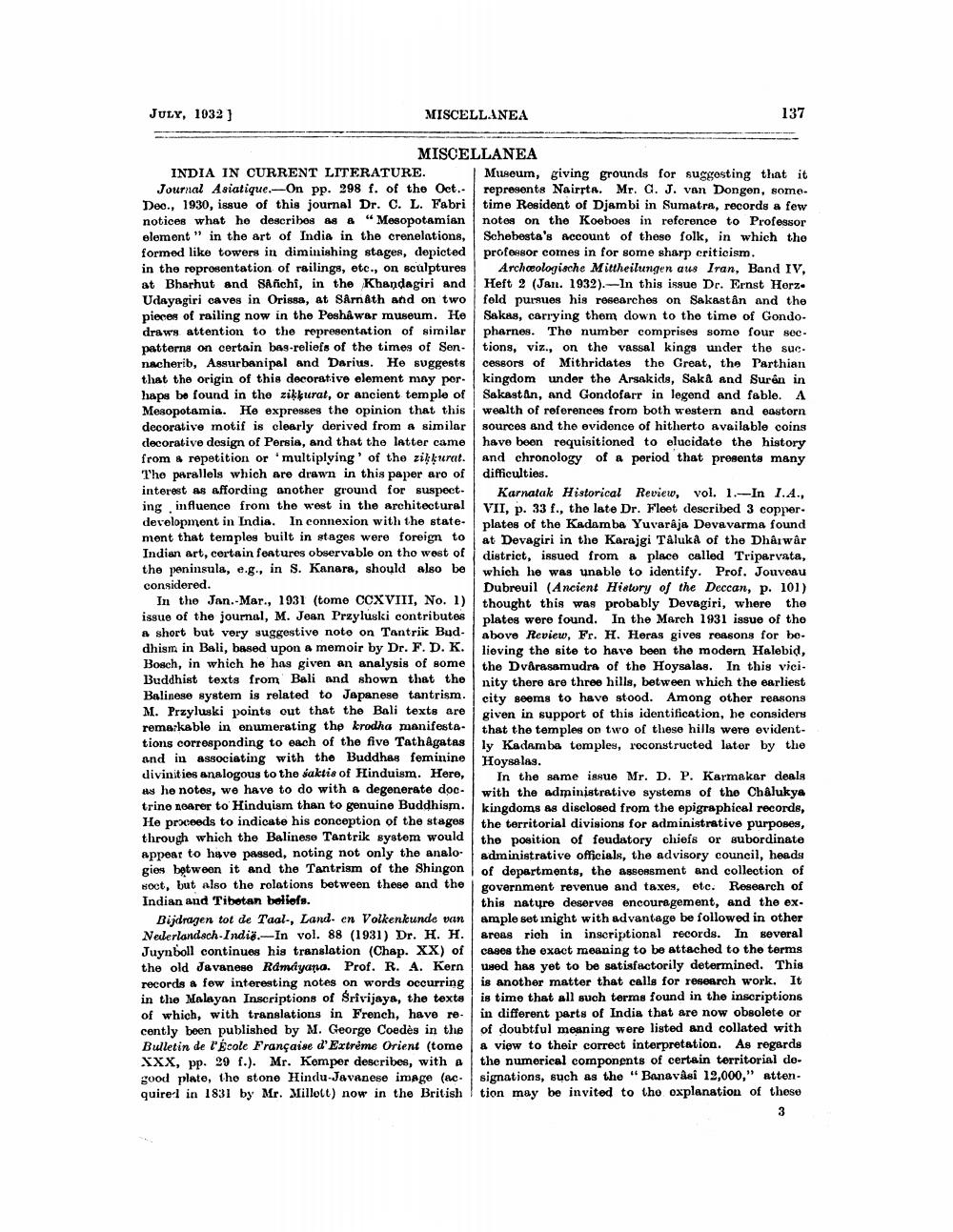________________
JULY, 1032 )
MISCELLANEA
137
MISCELLANEA INDIA IN CURRENT LITERATURE. Museum, giving grounds for suggesting that it Journal Asiatique.-On pp. 298 1. of the Oct. represents Nairrta. Mr. C. J. van Dongen, some. Dec., 1930, issue of this journal Dr. C. L. Fabri time Resident of Djambi in Sumatra, records a few notices what he describes as a “Mesopotamian notes on the Koeboes in reference to Professor elemont" in the art of India in the crenelations, Schebesta's account of these folk, in which the formed like towers in diminishing stages, depicted professor comes in for some sharp criticism. in the representation of railings, etc., on sculptures Archeologische Mitteilungen aus Iran, Band IV, at Bharhut and SAfichi, in the Khandagiri and Heft 2 (Jan. 1932).-In this issue Dr. Ernst HerzUdayagiri caves in Orissa, at Sarnath and on two feld pursues his researches on Sakastan and the pieces of railing now in the Peshawar museum. He Sakas, carrying them down to the time of Gondo. draws attention to the representation of similar pharnes. The number comprises somo four secpatterns on certain bas-reliefs of the times of Sen. tions, viz., on the vassal kings under the suc. nacherib, Assurbanipal and Darius. He suggests cessors of Mithridates the Great, the Parthian that the origin of this decorative element may por. kingdom under the Arsakids, Saka and Suren in haps be found in the zikkurat, or ancient temple of Sakastan, and Gondofarr in legend and fable. A Mesopotamia. He expresses the opinion that this wealth of references from both western and eastorn decorative motif is clearly derived from a similar sources and the evidence of hitherto available coins decorative design of Persia, and that the latter came have been requisitioned to elucidate the history from a repetition or multiplying of the zilkurat. and chronology of a period that presents many The parallels which are drawn in this paper aro of difficulties. interest As affording another ground for suspect. Karnatak Historical Review, vol. 1.-In 1.A., ing influence from the west in the architectural VII, p. 33 f., the late Dr. Fleet described 3 copper. development in India. In connexion with the state. plates of the Kadamba Yuvarâja Devavarma found mont that temples built in stages were foreign to at Devagiri in the Karajgi Taluka of the Dharwar Indian art, certain features observable on tho west of district, issued from a place called Triparvata, the peninsula, e.g., in S. Kanara, should also be
which he was unable to identify. Prof. Jouveau considered.
Dubreuil (Ancient History of the Deccan, p. 101) In the Jan.-Mar., 1931 (tome CCXVIII, No. 1) thought this was probably Devægiri, where the issue of the journal, M. Jean Przyluski contributes plates were found. In the March 1931 issue of tho & short but very suggestive noto on Tantrik Bud- above Review, Fr. H. Horas gives reasons for bedhism in Bali, based upon a memoir by Dr. F. D.K. lieving the site to have been the modern Halebid, Bosch, in which he has given an analysis of some
the Dvårasamudra of the Hoysalas. In this vici. Buddhist texts from Bali and shown that the nity there are three hills, between which the earliest Balinese system is related to Japanese tantrism. city seems to have stood. Among other reasons M. Przyluski points out that the Bali texts are given in support of this identification, he considers remarkable in onumerating the krodha manifesta. that the temples on two oft tions corresponding to each of the five Tathagatas
ly Kadamba temples, roconstructed later by the and in associating with the Buddhas feminine
Hoysalas. divinities analogous to the saktis of Hinduism. Here, In the same issue Mr. D. P. Karmakar deals as he notes, we have to do with a degenerate doc
with the administrative systems of the Chalukya trine nearer to Hinduism than to genuine Buddhism. kingdoms as disclosed from the epigraphical records, He proceeds to indicate his conception of the stages
the territorial divisions for administrative purposes, through which the Balinese Tantrik system would
the position of feudatory chiefs or subordinate appear to have passed, noting not only the analo
administrative officials, the advisory council, heads gies between it and the Tantrism of the Shingonl of departments, the assoalment and collection of soct, but also the rolations between these and the government revenue and taxes, etc. Research of Indian and Tibetan beliefs.
this nature deserves encouragement, and the exBijdragen tot de Taal-, Land- en Volkenkunde van ample set inight with advantage be followed in other Nelerlandsch-Indië. In vol. 88 (1931) Dr. H. H. Broas rich in inscriptional records. In several Juynboll continues his translation (Chap. XX) of cases the exact meaning to be attached to the terms the old Javanese Ramayana. Prof. R. A. Kern used has yet to be satisfactorily determined. This records a few interesting notes on words occurring is another matter that calls for research work. It in the Malayan Inscriptions of Srivijaya, the texts is time that all such terms found in the inscriptions of which, with translations in French, have re in different parts of India that are now obsolete or cently been published by M. George Coedès in the of doubtful meaning were listed and collated with Bulletin de l'école Française d'Extreme Orient (tome a view to their correct interpretation. As regards XXX, pp. 29 f.). Mr. Kemper describes, with the numerical components of certain territorial do good plate, the stone Hindu-Javanese image (Ac. signations, such as the "Banavasi 12,000," attenquired in 1831 by Mr. Millott) now in the British I tion may be invited to tho oxplanation of these




